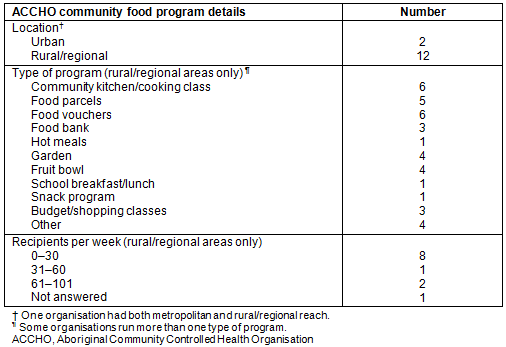Dear Editor
Access to affordable, nutritious food is essential to close the life expectancy gap between Aboriginal and non-Aboriginal people1,2. However, the Victorian Population Health Survey revealed that Aboriginal Victorians are four times more likely than non-Aboriginal Victorians to experience food insecurity3.
In recognition of the critical need to improve food security for Aboriginal people in Victoria, the Victorian Aboriginal Community Controlled Health Organisation (VACCHO) partnered with SecondBite, an Australian food rescue organisation. In 2013, the two organisations initiated a cross-sectional survey of community food programs (CFPs) targeting Victorian Aboriginal people. CFPs describe any initiative that provides free or subsidised food to vulnerable people.
The 34-item online survey was distributed to all Aboriginal Community Controlled Health Organisations (ACCHOs) in Victoria via email. Of the 27 ACCHOs, 12 indicated that they deliver a CFP in rural and regional Victoria; Table 1 summarises survey responses from the ACCHOs.
The survey results revealed that many rural and regional programs focus not only on the provision of food, but also nutrition knowledge and skills. For example, many organisations indicated that running a CFP was an opportunity to provide new recipes, healthy eating advice and budgeting skills. Survey respondents also indicated that CFPs provide an important social forum for the community and also play a role in attracting people to other health and family services provided by the organisation.
Of note, eight rural/regional ACCHOs (67%) indicated they had a policy regarding the types of food that should and should not be provided to their community. This 'upstream' approach may have been influenced by the statewide nutrition policy training and support provided by VACCHO's nutrition team4.
These survey results may not provide a complete picture of Aboriginal CFPs run by ACCHOs in Victoria or represent all Aboriginal CFPs; however, they provide a useful snapshot of how some rural and regional ACCHOs are responding to the food and nutrition needs of their local Aboriginal communities. Such programs are deemed essential services by many Victorian ACCHOs and are often implemented without specific funding5.
Food insecurity is a complex issue which affects many Aboriginal people living in Victoria. The survey results suggest that CFPs are a central component of many rural and regional Victorian ACCHOs. The strategic partnership between VACCHO and SecondBite provided an opportunity to identify and guide future work to support food security initiatives. Rigorous evaluation and capacity-building strategies are now required to support the staff and volunteers providing these essential programs for Aboriginal people throughout rural and regional Victoria.
Table 1: Community food programs targeting Victorian Aboriginal people - Victorian Aboriginal Community Controlled Health Organisation survey responses

Michelle Gooey, MBBS (Hons) MPH, Volunteer Research Officer, SecondBite, Melbourne, Victoria, Australia
Jennifer Browne, BNutr&Diet, MPH, Public Health Nutritionist (Accredited Practising Dietitian), Victorian Aboriginal Community Controlled Health Organisation, Melbourne, Victoria, Australia
Sharon Thorpe, BAplSci, GradDipHlthProm, Aboriginal Nutrition Project Officer, Victorian Aboriginal Community Controlled Health Organisation, Melbourne, Victoria, Australia
Liza Barbour, APD, BNutr&Diet, GradCertIntHlth, GradCertDiabEd, MPH, Accredited Practising Dietitian, Nutrition Programs Manager (National), SecondBite, Melbourne, Victoria, Australia
References
1. Browne J, Laurence S, Thorpe S. Action on food insecurity in urban Aboriginal and Torres Strait Islander communities. (Internet) 2009. Available: http://www.healthinfonet.ecu.edu.au/health-risks/nutrition/other-reviews (Accessed 17 July 2013).
2. Thorpe S, Browne J. Closing the nutrition and physical activity gap in Victoria: Victorian Aboriginal Nutrition and Physical Activity Strategy. Melbourne: Victorian Aboriginal Community Controlled Health Organisation, 2009.
3. Department of Health. The health and wellbeing of Aboriginal Victorians: the Victorian Population Health Survey supplementary report. Melbourne: Victorian Government, 2008.
4. MacDonald C, Genat B, Thorpe S, Browne J. Establishing health promoting workplaces in Aboriginal community organisations: healthy eating. Australian Journal of Primary Health 2015; 22(3): 239-243. http://dx.doi.org/10.1071/PY14144
5. Murray M, Bonnell E, Thorpe S, et al. Sharing the tracks to good tucker: identifying the benefits and challenges of implementing community food programs for Aboriginal communities in Victoria. Australian Journal of Primary Health 2014; 20(4): 373-378. http://dx.doi.org/10.1071/PY14038


